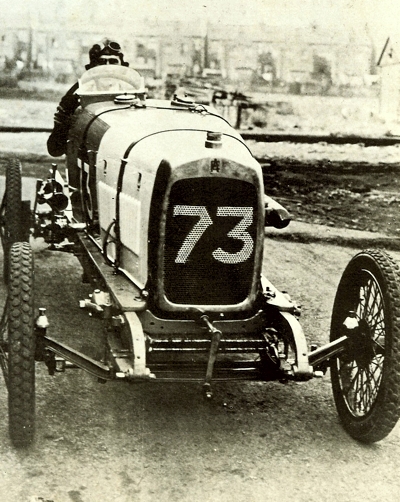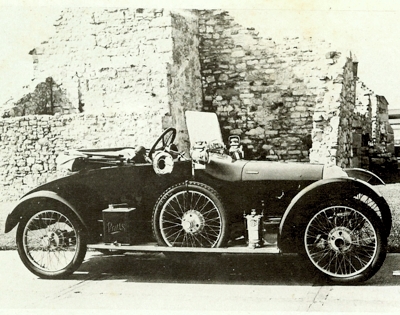|
Enfield Autocar Company
|
1904
- 1926 |
Country: |
 |
|
'MADE LIKE A GUN' was the proud slogan of the Enfield Cycle Company of Redditch, Worcestershire, who were well known as armament and cycle manufacturers long before they became involved with motor vehicles.
In 1900 Enfield made their first powered vehicle, which was decidedly unambitious - a light motor cycle with the engine mounted in front of the steering head, driving the rear wheel through a crossed belt-but the company had soon progressed to two-wheelers of a more substantial nature, with the engine in the more conventional position.
From motor cycles, it was only a short step to motor quadricycles, one of which was Henry Royce's first vehicle. These early Royal Enfields generally used De Dion engines of 2¾ and 3½ hp, though the company did produce their own power units, one of which was water-cooled, with the final drive by chain from the timing shaft.
By 1904 Royal Enfield were building motor cars: initially a range of two models was marketed, both built on orthodox lines. The 6 hp two-seater had a De Dion single-cylinder engine and was, claimed the makers, specially constructed for heavy work and hilly districts; its specification included a three-speed gearbox and 'three brakes'. Prices started from £175.
The 10 hp, which cost £300 (£325 with leather upholstery and 'Modele Riche' finish), was a twin-cylinder four-seater with a honeycomb radiator augmented by a water tank on the dashboard. Both cars had tubular chassis, that of the larger car being braced to stop the machine from folding in the middle.
Cars designed by E. H. Lancaster
In 1906 the car-manufacturing operation became independent of the parent company, and began production of a more substantial range of cars, designed by E. H. Lancaster. These were a 4.1-liter 16/20 hp and a 5.9-liter 24/30 hp. Both had four- cylinder engines, pressed-steel chassis and live-axle final drive, there were three powerful metal-to-metal compression brakes, and the Enfield radiator incorporated 1200 round tubes for maximum cooling.
Accessibility was a feature of the design - the clutch could, it was claimed, be dismantled without disturbing the engine or gearbox, while the gearshafts ran on ball bearings, and could be reached through large inspection plates at the top and bottom of the gearbox. Ignition was by coil and battery, rather than the more up-to-date magneto, and the 16/20 cost £420 complete, while the 24130 was £480 as a chassis, £525 including coachwork.
The following year a smaller 15 hp model replaced the 16/20; it was, however, short-lived, and at the Olympia Show in November 1907, the stand was occupied by four 18/22 hp Enfields, at prices ranging from £341 for the bare chassis to £407 for the Standard Car with detachable top, back and centre lights - an ideal car for town and country. But these cars were not what they seemed, a glance at the power units revealed that these were identical to those fitted to the 20/25 Alldays & Onions.
 Pictured above is a 1922 200 Mile Race Enfield-Allday, with J. Chance at the wheel.
Pictured above is a 1922 200 Mile Race Enfield-Allday, with J. Chance at the wheel.
 At the end of 1913 Enfield launched a four cylinder 9 hp model priced at £158. This became known as the 'Nimble Nine'. The car was a two-seater tourer and the bodies were produced by Enfield itself.
At the end of 1913 Enfield launched a four cylinder 9 hp model priced at £158. This became known as the 'Nimble Nine'. The car was a two-seater tourer and the bodies were produced by Enfield itself. |
Taken over by Alldays & Onions
The independent existence of the Enfield Autocar Company had lasted less than two years before failing finances had led to their takeover by the Alldays & Onions Pneumatic Engineering Company of Birmingham, an engineering firm which could trace its origins back as far as the mid 1600s and had produced its first car, a wheel-steered quadricycle, in 1898. After the take over the Enfield range was composed of deluxe versions of Alldays models; in mid 1908, the company moved from its works at Hunt End, Redditch, to a factory at Fallows Road, Sparkbrook, Birmingham.
The first three models from the new factory were shown at Olympia in November 1908. They consisted of the 10/12 hp Popular two-cylinder, price 212 guineas (the little voiturette had originally been introduced by Alldays in 1905, and survived until 1913), the 18/24 and a survival from the past in the shape of an updated 30/35, the only one of the Lancaster designs to survive the takeover, and one which had no Alldays counterpart. The fourth model in the range, the 16 hp four, was not at the Show.
Two new models appeared in the 1911 line-up: a 12 hp light four based on the new Alldays and a 20 hp. Later that year, the company attempted to break into the cyclecar market with the Autorette, a two-cylinder, two-speed three-wheeler retailing at £95, but it was soon replaced by the more conventional - and costly - 7/8 hp, vee-twin Autolette four-wheeler with worm final drive. From 1911 on the four-cylinder models were available with a self starter. Dynamo lighting appeared in 1913.
The Nimble Nine
Sales of the Autolette during 1913 were encouraging enough for the company to launch a 9 hp four-cylinder variant at the end of the year, priced at £158 against the twin's £138; this model became the famous Nimble Nine in 1914, by which time the company was switching over to White & Poppe proprietary engines for the larger 14.3 hp and 18A hp cars. Unusually for the period, Enfield built their own bodies, adopting a pleasingly ungainly flush-sided torpedo line for 1914; special coachwork was normally supplied by Mulliners.
Enfield-Allday Motors Limited
Rationalisation was carried to its logical conclusion after the war, with Alldays and Enfield merging as Enfield-Allday Motors Limited, based at Sparkbrook. But in place of the modestly-priced, ultra-conservative family cars' of the pre-war era, the company proposed a complete breakaway from established canons of car design. Their 1919 Bullet was largely the work of A. W. Reeves, who had designed the famous 25 hp RFC model Crossley; he was aided by A. C. Bertelli, Enfield-Allday's works manager.
The Bullet drew heavily on wartime aero-engine developments, and featured a five-cylinder radial engine mounted in a triangulated chassis carried on long cantilever springs. The gearbox was mounted at the apices of the chassis side-members, and the air-cooled engine could be rotated for servicing requirements by just undoing a couple of bolts. The power unit featured curious concentric inlet and exhaust valves,' claimed to give the maximum in efficiency, though 23 bhp from a 2.5-liter engine was hardly inspiring, even in 1919, as by now the development of the motor car was well under way.
All-up weight was said to be as low as 9·75 cwt, contributing to a 40 mpg petrol consumption, but the new car was too complex for economy of production. The price was originally £350, but this kept going up, as the design was unsuitable for mass production. Total output was perhaps four cars, and a larger 15 hp version with a six-cylinder sleeve-valve engine and more orthodox chassis and suspension did not seem to have passed the artist's impression stage.
Bertelli hurriedly designed a replacement, a conventional four-cylinder car with inclined side valves, remarkable only for its quality of finish - '
Never before has such skill, material and fine workmanship been put into a light car', boasted the company. But once again, the design was not suited to economical production, and only a hundred or so of the 10/20 and 12/30 Enfield-Alldays were built before production ended in 1925 and the company's final factory, at Small Heath, Birmingham, closed down.
The Remington & Bertelli
The model had enjoyed some modest sporting successes, so Bertelli attempted to strike out on his own with a sports car - the Remington & Bertelli - which had an overhead camshaft 1.5-liter engine in a racing Enfield-Allday chassis; but in 1926 he acquired the moribund Aston Martin company from Lionel Martin, and the Remington & Bertelli formed the basis of the Aston Martins built between 1926 and 1929 in Feltham, Middlesex.
